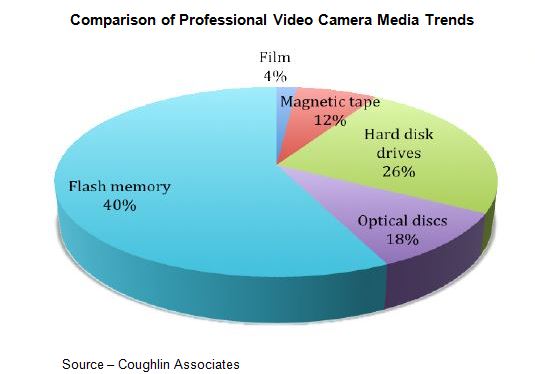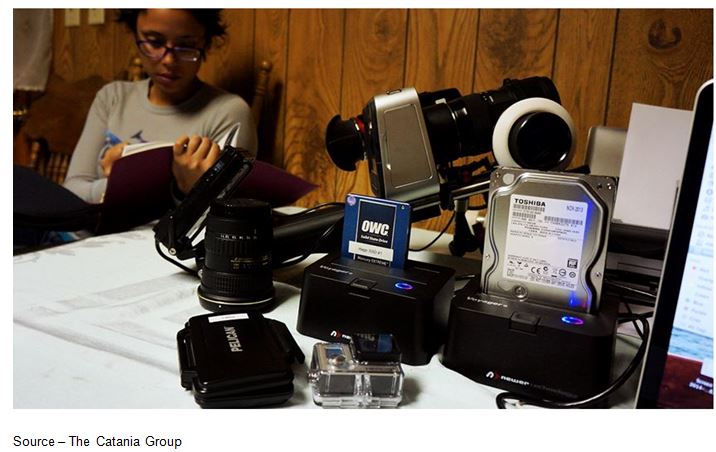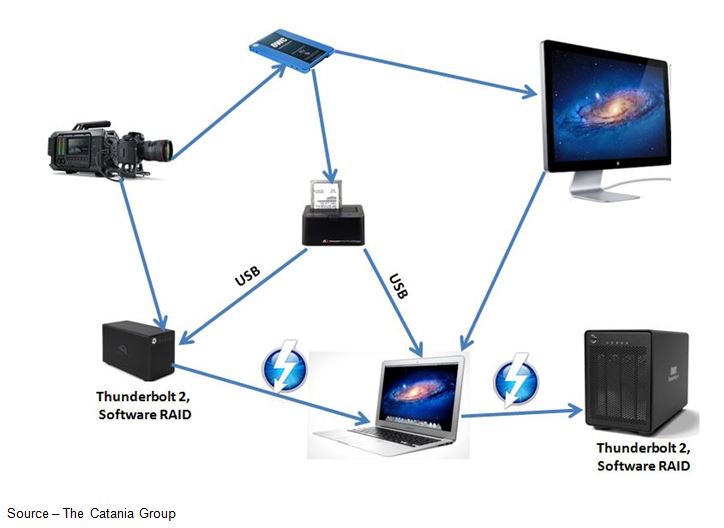 By Andy Marken
By Andy Marken
The M&E industry even though it's sometimes hard to realize with the land seemingly shifting under your feet.
As long as you don't think about it too hard, today's entertainment is great.
Think just a little and its freakin' amazing -- you can watch it in a theater; on your TV set (old- fashioned cable or Over The Top – OTT – internet); on your computer, tablet, smartphone and probably soon on your wearable.
Think about it real hard and you realize why an acquaintance of ours, Clyde Smith, Senior Vice President of New Technologies for FOX Network Engineering and Operations, straddles both Hollywood and Silicon Valley out of necessity.
Years ago, he said, "If you can't identify it, you can't operationalize or measure it; if you can't measure it you can't monetize it."
That's what old Hollywood and the new breed want ... to make money!
Even though Clyde is very involved in the SMPTE/HPA (Society of Motion Picture and Television Engineers/Hollywood Post Alliance), he also took more than a passing interest in the Vanity Fair New Establishment Summit, the emerging entertainment event.
Heck, he even associates with New Establishment people at companies like YouTube, Yahoo Video, HuffintonPost, AOL Video and Netflix.

A Lot Alike – Hollywood and New Hollywood (Silicon Valley) have a lot in common ... very shallow super talent pools. Last year, Yahoo's former chief content officer was enticed away by Maker Studios, one of the biggest YouTube multichannel network operators. At Yahoo, she led Yahoo's video acquisition and development, including launching Yahoo Studios but money talks and the lady walks.
A lot of his Hollywood contemporaries make no bones about being at war with tech folks. After all, their content is being stolen, parsed out and they're forcing a change in the distribution/monetization landscape they aren't comfortable with.
What the new kids don't understand/acknowledge is that SMPTE/HPA has a 100-year track record of establishing the standards that let us enjoy our content on any device, any time, any where we want today.
Smith added, "Maybe we didn't know it at the time, but the industry made it possible for the technology industry and the kids to make 'our' art form available to the masses.
"They've opened the creative floodgate to a whole new breed of content creators with inexpensive cameras/ingest devices; compact/affordable production/post production systems and editing/authoring/FX/post tools. Now, we're all adding features, capabilities that are making video content the worldwide standard for communications, entertainment, enlightenment."
At about 6ft 5in and plenty smart, not many people disagree with him.
What we're seeing in both the Hollywood and Silicon Valley scenes is that the novelty of streaming cat videos no longer holds the eyeballs on any screen and we've raised the viewers' expectations.
The big question in both sectors is how much content (how big/deep/rich) is too much?

Bigger is Better – Almost everyone is producing content in richer, more intensive 4K to entertain people in newer, more exciting ways. More pixels, more data is being added to bring content to life for you, regardless of your screen.
The biggest discussion continues to be 4K becoming a reality and the open-ended question as to whether people really perceive enough of a difference with pixel count between 2K, 4K, 8K and beyond or the differences in content shot/shown at 24 fps, 48 fps, 60 fps and 120 fps.
New technology standards like H.265 make it easier to stream 4K content over the internet to today's UHD TV channels such as UltraFlix on the newest sets and people say they can see the difference.
But there is a question of true quality perception when that content is streamed to a mobile device.
Mobile content offers a fresh new set of revenue streams for content owners but already 3G/4G networks can't keep up and LTE (long-term evolution) is still a "work in progress."
With Cisco already forecasting that mobile data rates will have to increase seven-fold from 0.5 – 4Mbps, carriers haven't really said what the streamed content will cost the consumer.
The Internet population of about three billion has changed the media industry and a whole new breed of independent film, video and content producers have emerged; the old guard is taking notice.
The industries are exploring the impact of enriched image/sound technology even though time and money are at a premium for the budget-constrained post production world.
About five years ago, I heard a Hollywood executive say that film was still basic form of entertainment capture/distribution and that it would probably continue to be through our lifetimes.

Camera Shift – Yesterday's film has rapidly disappeared from the M&E industry as the medium of choice, along with the high cost of cameras, lenses and associated gear. Solid-state storage has become the medium of choice, despite its slightly higher cost, because it is rugged and reliable.
Today, it's almost insignificant.
We've rapidly gone through an era of change and now we're trying to figure out how to optimize it for content producers, distributors and consumers.
The new media isn't created in a backlot somewhere; it's done in makeshift garage studios or more often, on site.

In the Field – The new breed of independent cinematographers can now take most of their gear with them to the shooting location with their digital cameras, SSD/HD storage and Mac systems to capture, store, protect their projects in the field. It may not be as glamorous as they depict in the movies, but the work gets done.
What I like about it is that all of those new economic 4K cameras and software solutions that can be used with cost-effective GPU (graphic processing unit) and CPU (central processing unit) systems.
Because at the end of the day, all of that creative and post work has to be stored ... somewhere.
How much are we talking about?
Consider one hour of the present/projected formats:
- HD – 22.5GB
- 2K – 716GB
- 4K – 6,880GB (6.88TB)
- 8K – 86,000GB (86TB)
To paraphrase Robert Duvall in Apocalypse Now, "I love the sound of content in the morning."
That's because a film is so much more than the RAW video shot or the finished work.
It's:
- Original media as shot
- Protected clone (never touched)
- Worker copy (files renamed, organized)
- Insurance copy of worker
- Studio copy of worker
- 3rd clone of worker...just in case
- Project output
- Clone, 2nd protection
- Maybe, just maybe, something for archive
That's probably why during a SMPTE presentation, Howard Lukk, of Pannon Entertainment, said that 4.25TB of raw content can end up consuming 75TB of storage.
It's enough to make a storage person's heart flutter.
And while the big iron/big storage suppliers think that's cool, what indie in his/her right mind is going to drop $50-$100K for storage when they don't even have an IT (information technology) person?
So cloud people jump in and say, "OMG, we know your pain and we're going to put it up there and life will be good."
The only flaw I see in that came when one of the SMPTE presenters made the statement, "You cannot build something without trust."
Damn that won me over!
I have nothing against the cloud because I pass a lot of stuff through it and if it's crap, I'm not really concerned about the fact that I even store it there.
But something vital, critical to my livelihood, my very future?
Ain't gonna happen!
It certainly isn't something any cautiously paranoid producer, cinematographer is going to entrust his/her work to.

Capture, Copy, Preserve – The number of independent cinematographers and post production organizations has grown dramatically over the past two years and shows no sign of slowing up because equipment and solutions are not only economical but easy to use, manage and maintain. Small shops simply don't have the luxury of specialized IT personnel to keep workflow moving smoothly.
At the SMPTE conference, Howard Lukk, head of Pannon Entertainment, also explained that he follows the storage path similar that Cirina Catania, founder/lead creative of The Catania Group, uses.
Their storage is in their studio/post production facility--even if is the converted spare bedroom.
Catania noted that she uses a generous mixture of SSDs (solid-state drives) and Thunderbolt 2 storage systems that use software RAID (random array of independent disks) that provide economic data redundancy, capacity, ready availability and, as Cirina said, "Peace of mind."
Camera folks at Blackmagic as well as cloud/local tool providers at Adobe and Autodesk agree.
All of them see very good growth in the high-end studio/professional post production business (10-100 seats) but the real growth is in the one-five (and up to 10) indie and specialty individuals and teams that use the old-fashioned sneakernet (physically moving storage from one workstation to another) and sending segments through the cloud when remote special talents are needed.

Count the Seats – While big companies tend to focus on the things they know best (big companies), the growth in the M&E industry is in the 1-10 cinematographer/post production operations because the cost of entry has dropped so dramatically for the new creative breed. In addition, new solutions are more feature-rich, easy to use all it takes now is a desire, a good idea, good script, good authoring/editing, good soundtrack, good action, good channel(s) of distribution, good audience.
The New Establishment (New Hollywood) won't kill the Hollywood you grew up with and knew as a kid because like it or not, they need each other and can learn from each other.
DreamWorks Animation and Disney have major YouTube channels and producers. CBS and HBO are setting up streaming OTT channels. Facebook, Alibaba, Netflix, NanoTech and Yahoo are striking new/different content licensing models.
Digital content creation, distribution and reception are changing dramatically and are opening up new – and different – opportunities for everyone in the food chain.

Don't Buy, Leverage – In the M&E industry (as in every industry), it always looks like it's the other guy (or gal) in the supply chain that is the one who is making all of the money so folks rush to get theirs by encroaching or buying. Somehow, the specialist always makes it look easy, too easy and stuff happens until the chain is reunited.
As Fox's Smith said, everyone involved needs to really work together to operationalize, measure and monetize it.
Who knows, it could just be a major source of revenue for a new/changed industry.
www.markencom.com


















































































